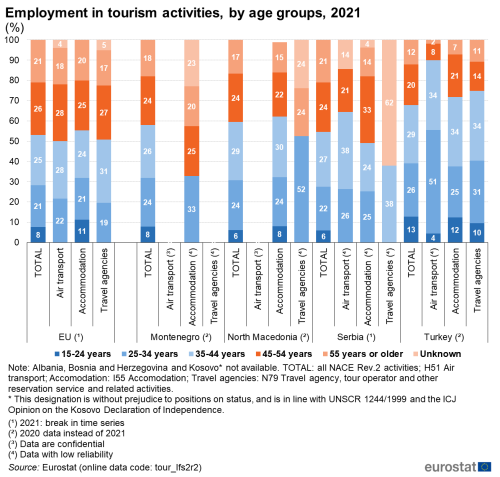Archive:Enlargement countries - tourism statistics
Data extracted in May 2022.
Planned article update: May 2023.
Highlights
There were more than 1.8 million bed places in hotels and similar establishments across the EU candidate countries and potential candidates in 2020, with 1.6 million in Turkey alone. In comparison, there were 11.9 million in the EU.
Aside from Montenegro, the number of hotel bed places grew in all of the EU candidate countries and potential candidates from 2010 to 2020. However, from 2019 to 2020, the number decreased by 39% in Montenegro and 20% in Bosnia and Herzegovina.
In 2020, almost 14.0 million tourists arrived at hotels in the EU candidate countries and potential candidates. This was more than two thirds (-69%) less than the 44.4 million arrivals in 2019, due to the Covid-19 pandemic and associated travel restrictions, with sharp falls in all of these countries.
This article is part of an online publication and provides information on a range of tourism statistics for the European Union (EU) and candidate countries and potential candidates, otherwise known as the enlargement countries. Montenegro, North Macedonia, Albania, Serbia and Turkey currently have candidate status, while Bosnia and Herzegovina as well as Kosovo* are potential candidates.
This article highlights recent developments concerning the capacity of the tourism sector in these countries, in terms of the number of bed places available in hotels and similar accommodation establishments, the number of arrivals of non-residents at tourist accommodation establishments and the number of trips made by outbound tourists.
Tourism plays an important role because of its economic and employment potential, as well as its social and environmental implications. Tourism statistics are not only used to monitor tourism policies but also regional and sustainable development policies.
Full article
Tourism infrastructure
There were more than 1.8 million bed places in hotels and similar establishments across the candidate countries and potential candidates in 2020; almost 88 % of these were in Turkey
The number of bed places available in hotels and similar tourist accommodation establishments provides one measure of a country’s capacity to attract tourists. In this context, it should be noted that official tourism statistics include business travellers as tourists, alongside individuals travelling for pleasure or other reasons. In 2020, the tourism sector in the seven EU candidate countries and potential candidates offered a combined total of more than 1.8 million bed places. By comparison, there were 11.9 million bed places in hotels and similar establishments across the EU in 2020. In Turkey alone, there were 1.6 million bed places available, 88 % of the total among these countries, the second largest capacity was found in Albania with 82 000 bed places, corresponding to 5 % of the total, and third highest in in Serbia (57 000; 3%). The capacity of bed places was roughly at the same level in Bosnia and Herzegovina (28 000), North Macedonia (24 000) and Montenegro (23 000), with Kosovo* at around half of this level (12 000).
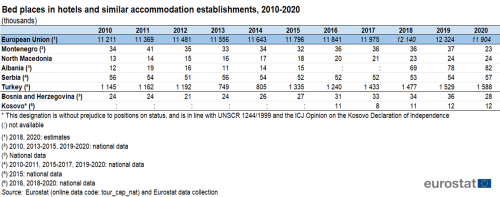
(thousands)
Source: Eurostat (tour_cap_nat) and national data
Aside from in Montenegro, the number of hotel bed places offered increased in all of the candidate countries and potential candidates in the decade from 2010 to 2020.
Throughout the decade from 2010 to 2020, Turkey was by far the largest supplier among the candidate countries and potential candidates of tourism capacity, in terms of the number of bed places available in hotels and similar accommodation. However, Turkey is also a much larger country than the other. As can be seen in Figure 1, in 2020 the tourism sector was much more important in Montenegro (36.2 bed places per thousand inhabitants) and Albania (28.9) than in Turkey (19.0), when the capacity in bed places in hotels are measured relative to the population size. Measured like this, the tourism sector also had higher importance in the EU (26.6) than in Turkey in 2020. All of these countries, as the EU, can offer tourism in mountain regions as well as in coastal regions with beaches, in addition to sites of historical and cultural interest, thus offering a wide range of tourism types.

(bed places per thousand inhabitants)
Source: Eurostat (tour_cap_nat), (demo_gind) and national data
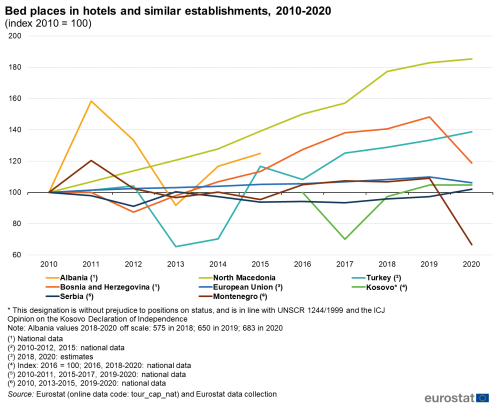
(index 2010 = 100)
Source: Eurostat (tour_cap_nat) and national data
Non-resident arrivals
Almost 14.0 million non-residents arrived at hotels and similar establishments in the candidate and potential candidate countries in 2020, down 69 % compared to the year before due to the Covid-19 pandemic
Table 2 shows the development in the number of arrivals of non-residents staying in hotels and similar establishments during the period 2010-2020.
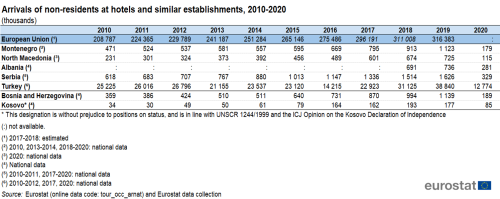
(thousands)
Source: Eurostat (enpe_tour_occ_arnat) and (tour_occ_arnat)
Figure 3 shows the number of arrivals of non-residents at hotels and similar establishments relative to the number of inhabitants over the period 2010 to 2020. In particular, it shows the sharp fall in the number of non-resident arrivals from 2019 to 2020 as tourism and other travel dropped strongly due to the Covid-19 pandemic arrivals of non-residents. In the EU, there were 709 arrivals of non-residents per 1 000 inhabitants in 2019.

(arrivals per thousand inhabitants)
Source: Eurostat (tour_occ_arnat), (demo_gind) and national data

(index 2010 = 100)
Source: Eurostat (tour_occ_arnat) and national data
Outbound tourism
Tourists and other travellers from Turkey made almost 9.7 million outbound trips in 2019
This section details the outward flow of tourists travelling abroad. EU tourists made 271 million non-domestic trips in 2019; note that EU data for this particular indicator are estimates and only refer to persons aged 15 years or older.
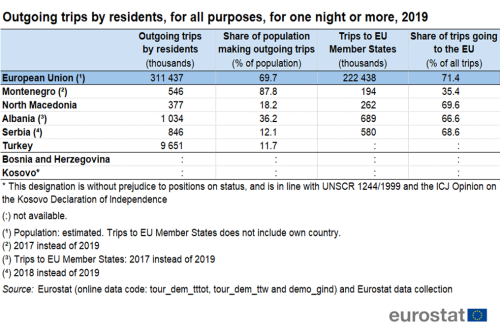
Source: Eurostat (tour_dem_tttot), (tour_dem_ttw), (demo_gind) and national data
Employment in the tourism sector
Tourism employment

(%)
Source: Eurostat (tour_lfs4r2)

(%)
Source: Eurostat (tour_lfs5r2)
Source data for tables and graphs
Data sources
Data for the candidate countries and potential candidates are collected for a wide range of indicators each year through a questionnaire that is sent by Eurostat to candidate countries or potential candidates. A network of contacts has been established for updating these questionnaires, generally within the national statistical offices, but potentially including representatives of other data-producing organisations (for example, central banks or government ministries). The statistics shown in this article are made available free-of-charge on Eurostat’s website, together with a wide range of other socio-economic indicators collected as part of this initiative.
Tourism, in a statistical context, refers to the activity of visitors taking a trip to a destination outside their usual environment, for less than a year. It can be for any main purpose, including business, leisure or other personal reasons other than to be employed in the place visited. A tourist is a visitor that stays overnight (at least one night).
Within the EU, a system of tourism statistics was established through Council Directive 95/57/EC of 23 November 1995 on the collection of statistical information in the field of tourism. This legal basis requires EU Member States to provide a regular set of comparable tourism statistics. The Directive was amended in 2004 and 2006, before being repealed in 2011 when the European Parliament and the Council of the European Union adopted Regulation (EU) No 692/2011 concerning European statistics on tourism. The 2011 Regulation on tourism statistics was amended in 2013, in 2019 and again in 2020; the current consolidated version of Regulation (EU) No 692/2011 incorporate all these amendments.
Tourism statistics in the EU consist of two main components: on the one hand, statistics relating to capacity and occupancy (supply-side tourism statistics); on the other, statistics relating to tourism demand. In most EU Member States, the former are collected via surveys filled in by accommodation establishments, while the latter are mainly collected via traveller surveys at border crossings or through household surveys. Statistics on tourism demand refer to tourist participation, in other words, trips of at least one overnight stay during the reference period.
Although the candidate countries and potential candidates produce some of these statistics on tourism capacity, occupancy and tourism demand and provide these to Eurostat, tourism data availability is still quite limited compared to that of the EU Member States.
Within the European Statistical System, statistics on the capacity of collective tourist accommodation include the number of establishments, the number of bedrooms and the number of bed places. These statistics are available by establishment type or by region and are compiled annually. Statistics on the occupancy of collective tourist accommodation refer to the number of arrivals (at accommodation establishments) and the number of nights spent by residents and non-residents, by establishment type or region; annual and monthly statistical series are available. In addition, statistics on the use of bedrooms and bed places (occupancy rates) are compiled.
Statistics on tourism demand in the EU are collected in relation to the number of tourism trips made (and the number of nights spent on those trips). The data are also analysed by the socio-demographic characteristics of the tourist.
Data from a range of other official sources may be used to study tourism. These statistics include:
- structural business statistics (SBS) and short-term business statistics (STS) which may be used to provide additional information on tourism flows and on the economic performance of certain tourism-related sectors;
- data on employment in the tourism accommodation sector from the labour force survey (LFS), analysed by working time (full/part-time), working status, age, level of education, sex, permanency and seniority of work with the same employer (annual and quarterly data);
- data on personal travel receipts and expenditure from the balance of payments;
- transport statistics (for example, air passenger transport).
Tables in this article use the following notation:
| Value in italics | data value is forecasted, provisional or estimated and is therefore likely to change; |
| : | not available, confidential or unreliable value. |
Context
Tourism has the potential to contribute towards employment and economic growth, as well as to the development of rural, coastal, peripheral or less-developed areas. Infrastructure created for tourism purposes contributes to local development, while jobs that are created or maintained can help counteract industrial or rural decline. Sustainable tourism involves the preservation and enhancement of cultural and natural heritage, ranging from the arts to local gastronomy or the preservation of biodiversity.
While basic principles and institutional frameworks for producing statistics are already in place, the candidate countries and potential candidates are expected to increase progressively the volume and quality of their data and to transmit these data to Eurostat in the context of the EU enlargement process. EU standards in the field of statistics require the existence of a statistical infrastructure based on principles such as professional independence, impartiality, relevance, confidentiality of individual data and easy access to official statistics; they cover methodology, classifications and standards for production.
Eurostat has the responsibility to ensure that statistical production of the candidate countries and potential candidates complies with the EU acquis in the field of statistics. To do so, Eurostat supports the national statistical offices and other producers of official statistics through a range of initiatives, such as pilot surveys, training courses, traineeships, study visits, workshops and seminars, and participation in meetings within the European Statistical System (ESS). The ultimate goal is the provision of harmonised, high-quality data that conforms to European and international standards.
Additional information on statistical cooperation with the enlargement countries is provided here.
Notes
* This designation is without prejudice to positions on status, and is in line with UNSCR 1244/1999 and the ICJ Opinion on the Kosovo Declaration of Independence.
Direct access to
- Enlargement countries — statistical overview — online publication
- Statistical cooperation — online publication
- All articles on non-EU countries
- Tourism statistics
- Tourism statistics at regional level
- Tourism trips of Europeans (online publication)
- All articles on tourism statistics
Statistical books/pocketbooks
- Key figures on enlargement countries — 2019 edition
- Key figures on enlargement countries — 2017 edition
- Key figures on the enlargement countries — 2014 edition
- Key figures on the enlargement countries — 2013 edition
- Pocketbook on the enlargement countries — 2012 edition
- Pocketbook on the enlargement countries — 2011 edition
'Factsheets
- Basic figures on enlargement countries — Factsheets — 2021 edition
Leaflets
- Statistics on tourism for the enlargement countries — 2020 edition
- Basic figures on enlargement countries — 2020 edition
- Basic figures on enlargement countries — 2019 edition
- Basic figures on enlargement countries — 2018 edition
- Basic figures on enlargement countries — 2016 edition
- Basic figures on enlargement countries — 2015 edition
- Basic figures on enlargement countries — 2014 edition
'Tourism in the EU
- Occupancy of tourist accommodation establishments (ESMS metadata file — tour_occ_esms)
- Annual data on trips of EU residents (ESMS metadata file — tour_dem_esms)
- Methodological manual for tourism statistics — version 3.1 — 2014 edition
- Projects and studies, see Methodology for tourism statistics and Tourism Satellite Accounts (TSA)
- Regulation (EU) No 692/2011 of the European Parliament and of the Council of 6 July 2011 concerning European statistics on tourism and repealing Council Directive 95/57/EC
- A renewed EU tourism policy: towards a stronger partnership for European tourism (Communication from the European Commission COM(2006) 134 final, March 2006)
- Agenda for a sustainable and competitive European tourism (Communication from the European Commission COM(2007) 621 final, October 2007)
Europe, the world’s No 1 tourist destination — a new political framework for tourism in Europe (Communication from the European Commission COM(2010) 352 final, June 2010)
